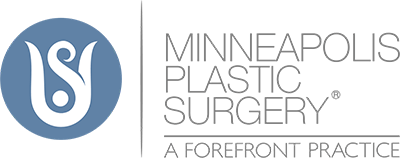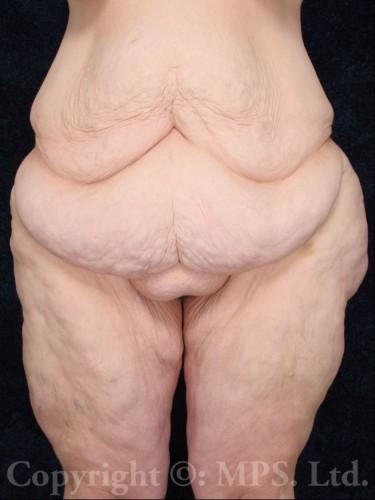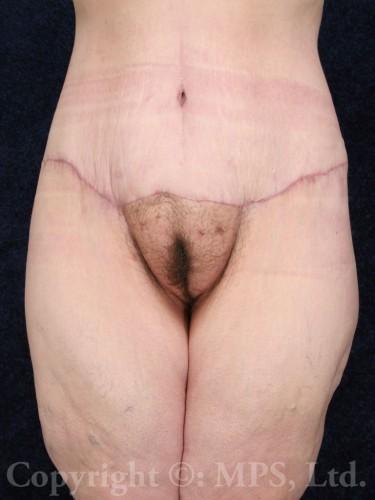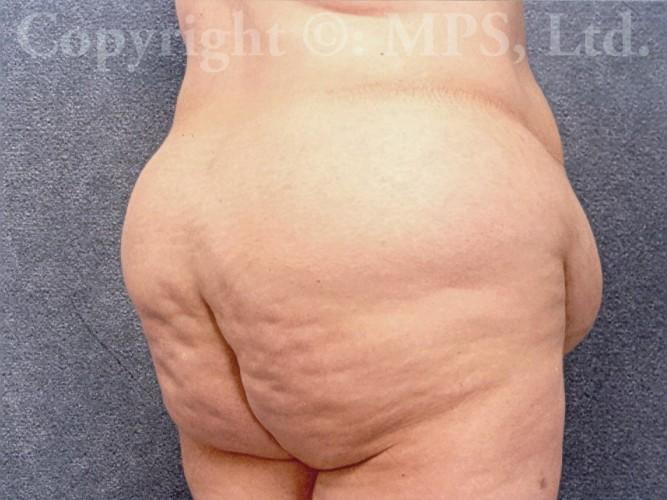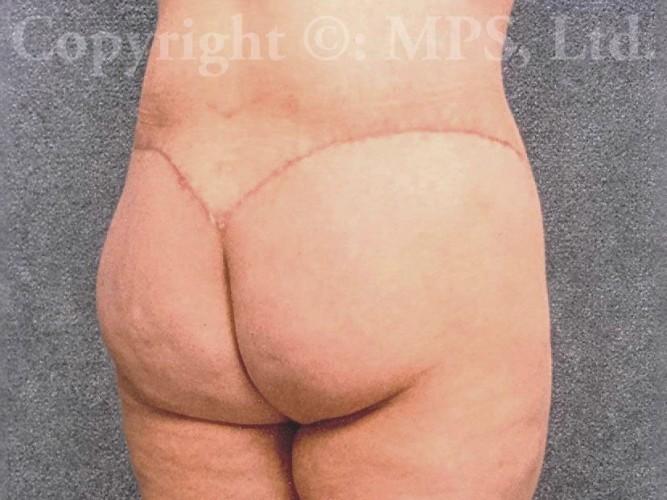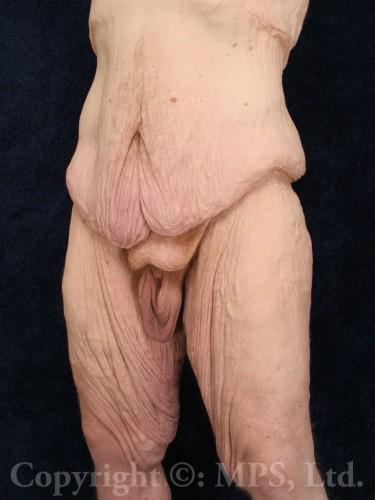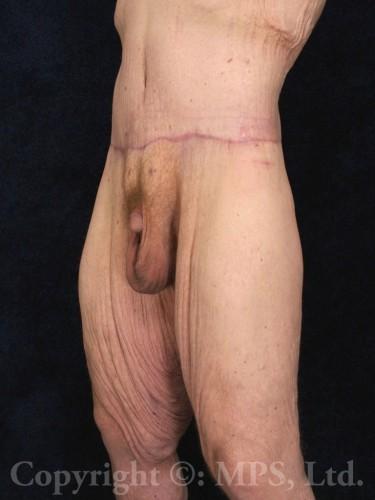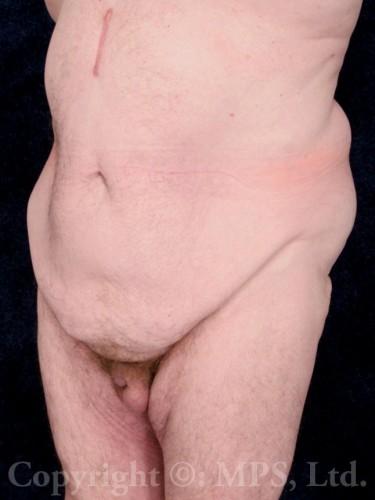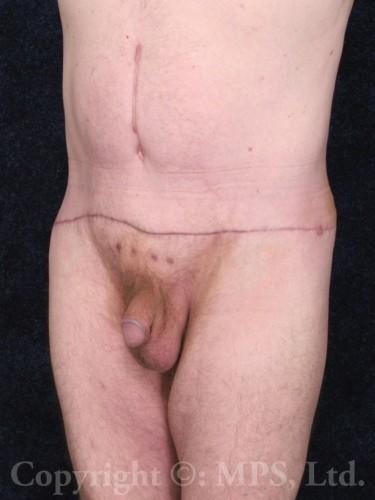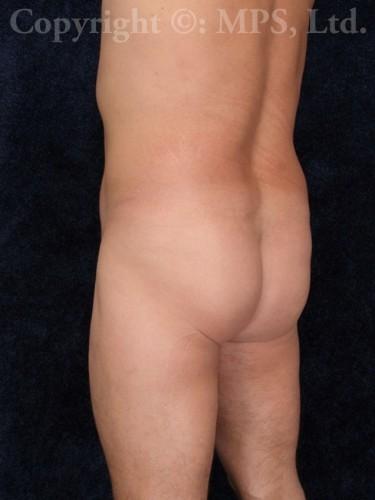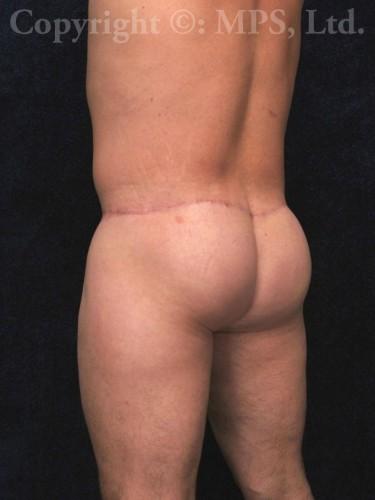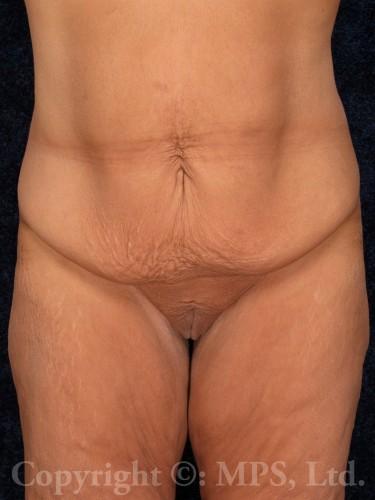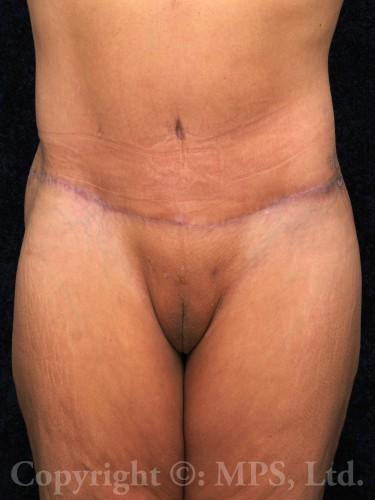Lower Body Lift / Torsoplasty / Belt lift
Most board-certified plastic surgeons perform cosmetic breast lifts and tummy tucks, and many perform thigh lifts and upper arm lifts, but a smaller number have extensive experience with buttock or full circumferential lower body lifts. Of the fewer plastic surgeons who perform beltlifts or “360 tummy tucks,” most will perform this more extensive surgery at the hospital, with an overnight stay for a day or even two. The plastic surgeons at Minneapolis Plastic Surgery, LTD., serving the Minneapolis / St. Paul area and beyond, have over 20 years’ experience with full circumferential belt lift, or lower body lift surgery done as an outpatient operation. Dr. Tholen and Dr. Gervais have also authored a Plastic Surgery textbook Chapter on over 260 cases of outpatient lower body lift. [Tholen RH, Gervais DL. Outpatient Lower Body Lift. Chapter 7 in: Thaller SR, Cohen M (eds), Cosmetic Surgery After Massive Weight Loss. JP Medical Publishers, 2013, pp. 39-56.].
WARNING:
This gallery contains nudity not suitable for those under 18 years of age. By viewing you acknowledge this warning
Prospective lower body lift surgery patients should always check that their surgeon is certified by the American Board of Plastic Surgery, which is one of 24 boards administered by the American Board of Medical Specialties (ABMS). Both surgeons at Minneapolis Plastic Surgery, LTD. are board-certified by the American Board of Plastic Surgery, and routinely perform outpatient lower body lift surgery at their on-site nationally-accredited (AAAASF) surgical center.
Candidates for Lower Body Lift Surgery
Massive weight-loss patients, whether they have had gastric bypass or lose their weight by other means, have invested a tremendous amount of time, effort, energy, and finances to reach the point where they now have loose, stretched skin that will not respond to anything but surgical removal. No amount of sit-ups, crunches, or leg lifts can rebuild the loss of elasticity and actual collagen content in skin that once contained another whole human in weight. Both Dr. Richard Tholen and Dr. Douglas Gervais frequently see patients who have exercised, dieted, and portion-controlled so well they have become extremely frustrated by the fact that their bodies have shrunk and their muscles toned, but their skin did not. Patients can feel betrayed by their bodies: they’ve worked so hard, yet still look anything but normal—they have gone from the poor self-esteem, public scorn, and disability of obesity, to feeling like bodybuilders in Shar-pei skin.
As massive weight loss patients reach their body weight goals, they contemplate the prospect of having multiple additional surgeries to remove and tighten their loose or sagging skin. One of the greatest areas of concern is the abdomen, where the “apron” or pannus of loose skin folds over the pubic area. Often this loose skin extends around to the lateral thighs, hips, and buttocks. A “standard” or even “extended” abdominoplasty (tummy tuck) does not do the necessary job— removal of an entire circumferential band of loose skin (“360 tummy tuck”). Our doctors term this procedure “circumferential belt lift plus abdominoplasty” or “lower body lift;” however, other surgeons use the term “torsoplasty” or “dermolipectomy” to refer to the same procedure. Some have even sub-classified them into Type I and II lifts. Regardless of the terminology used, lower body lift surgery is best for people who have the following problems:
- Excess, loose, sagging lower body skin (abdomen, buttocks, hips, and thighs), often after massive weight loss
- Weakened lower body muscles due to genetics, pregnancy, or aging
- Excess lower body fat in the abdomen, pubic area, buttocks, and thighs
Lower Body Lift in a Hospital
A full lower body lift is an operation that not every plastic surgeon performs, and even fewer have extensive experience with, causing most doctors to describe these operations as “lengthy, difficult, expensive, and requiring days of inpatient hospital care.”
Regardless of where the operation is performed, lower body lift operations require a surgical team experienced in total body prepping, capable of making at least three position changes of the anesthetized patient on the operating table to reach all the way around the body with the incisions and sutures, and possessing the technical surgical and anesthesia expertise needed to do this all safely, with minimal blood loss, while maintaining a sterile surgical field. A review of the surgical literature reveals that most surgeons who perform this procedure require inpatient hospitalization, some utilize the assistance of a second plastic surgeon, and virtually all require six to nine or more hours in the operating room.
This long an operation with traditional hospital anesthesia often results in prolonged time in the recovery room, as well as post-operative nausea and vomiting from some of the anesthetic agents, such as inhalation anesthesia, nitrous oxide, and intravenous morphine or other narcotic drugs. These medications, while providing safe and effective anesthesia, dilate the gut and middle ear, slow peristalsis in the intestinal tract and stomach, and accumulate in fatty tissue, causing dizziness, bloating, nausea, vomiting, and a nasty smell as your body exhales these gases that have accumulated for hours in fatty tissues. Anti-nausea medication works for some, but as many as one in four patients requires an overnight stay. The cost of this type of hospital lower body lift and inpatient care can be 35, 40, or even 50 thousand dollars. Add another day or two of hospitalization and the cost goes up again.
Hospitals utilize this type of inhalation gas anesthesia because it is safe, but also because it is very inexpensive, particularly for longer operations. It’s also what they have become accustomed to and are comfortable with. Cost, especially for large hospitals or networks, is a major factor in anesthetic drug choice. “Standard” anesthetics purchased in bulk are inexpensive, and the cost for additional hours in the recovery room fighting nausea and vomiting, or admission for overnight stay, is “someone else’s” cost—yours. Some studies show post-operative nausea and vomiting rates with this type of anesthesia as high as 7-28 percent. When an elective cosmetic patient is the one staying overnight, or a day or two, the patient pays the additional cost, not an insurance company.
Lower Body Lift in Our Surgical Center
Minneapolis Plastic Surgery, LTD. has offered full anesthesia services for major cosmetic outpatient surgical procedures in our three nationally-accredited (AAAASF) operating rooms for over 30 years. Since 1991, our practice, which serves the entire Minneapolis / St. Paul metropolitan area, has offered full general anesthesia capability, but with one significant difference from the hospital routine—we have perfected the everyday/every case use of total intravenous general anesthesia (TIVA) not just for induction of anesthesia, but for the entire operation. We use little or no inhalation anesthetic agent, and the same goes for nitrous oxide—they just contribute to too much nausea.
MPS also does some innovative things with pain and inflammation management: we pre-treat to avoid nausea, swelling, and muscle pain, and right before wake-up we routinely inject long-acting and extended-release local anesthetics into areas of muscle spasm or incisional discomfort—in short, we do battle with all the causes of pain, nausea, and vomiting, even though this anesthetic regimen is much more costly. With over 20 years of using this type of high-tech, higher-cost anesthesia, we have reduced our nausea rate to approximately three percent, and that includes extensive six and seven-hour operations on all parts of the body, such as lower body lifts. Of course, Dr. Gervais and Dr. Tholen have the advantage of performing elective surgical procedures on motivated patients who are healthy and pre-screened by their own physicians prior to having cosmetic surgery at our Minneapolis, Minnesota surgical center.
Minneapolis Plastic Surgery, LTD.’s first complete belt lift plus abdominoplasty, along with medial thigh lift and some liposuction, was performed in 1997. Since that time, Dr. Tholen and Dr. Gervais have performed over 300 full circumferential belt lift plus abdominoplasty or medial thigh lift operations as outpatient procedures in their AAAASF-accredited office operating facility. Every patient has gone home (with adult supervision) the same day as their lower body lift procedure. With outpatient surgery, comfort and mobility are enhanced; avoidance of contact with sick patients or nasty hospital bacteria is also achieved, reducing complications and other risks while also reducing costs.
Each plastic surgeon at Minneapolis Plastic Surgery, LTD. has his own full surgical and anesthesia team, and each operates daily. In fact, two outpatient lower body lift procedures have been performed at the same time on several occasions at our practice. A limited number of plastic surgeons have this degree of experience and expertise with this type of operation, but to our knowledge, no other practice performs this specific operation consistently as an outpatient procedure as often and as safely as Minneapolis Plastic Surgery, LTD.
Safe and effective body lifting procedures done as outpatient operations have been pioneered and advanced by the ABPS-certified plastic surgeons at MPS, and have been featured in a textbook chapter in the plastic surgical literature [Tholen RH, Gervais DL. Outpatient Lower Body Lift. Chapter 7 in: Thaller SR, Cohen M (eds), Cosmetic Surgery After Massive Weight Loss. JP Medical Publishers, 2013, pp. 39-56.].
Recovery and Results
In a presentation to the Midwestern Association of Plastic Surgeons in April 2005 and at an International Plastic Surgery Conference in January 2007, Dr. Tholen taught the specifics of the requirements for safe outpatient circumferential belt lift surgery. “Anesthesia is the first of several essentials,” he explained. “It has to be done in a way that avoids any potentially nausea-causing medications. Dr. Gervais and I were happy to report no major complications, and I believe that this procedure being done as an outpatient may actually reduce some complications, since our patients are required to be up walking, going to the restroom, and returning for office rechecks more quickly than hospital patients. This reduces swelling and bruising, keeps blood moving in the legs to reduce the risk of blood clots, and helps to get their intestinal tract working faster than the bedridden patient. Outpatient surgery also avoids contact with sick patients and nasty bacteria found in a hospital.”
“Our average operating time with one surgeon (and RN first assistant) was 5.5 hours, including additional cosmetic procedures in almost half of our patients. The most common additional procedures were liposuction, gynecomastia surgery (male breast reduction), ventral hernia repair, and breast augmentation. We removed an average of 8.2 pounds of skin and fat per patient (up to 23.7 pounds in one patient), and an additional two pounds via liposuction. Just over 2 percent of patients had post-operative nausea, and there were 17 percent minor complications, all of which were resolved with conservative outpatient care. Patient satisfaction was very high, especially considering the savings of thousands compared to similar operations performed as hospital cases.”
Since those reports, we have continued to refine and improve on the details of our outpatient circumferential lower body lift operation, and have removed as much as 31.4 pounds of loose skin and fat in one individual, with continued lower risk, improved outcomes, and decreased cost compared to lower body lifts being done in a hospital.
Cost for Lower Body Lift (Circumferential Beltlift)
Total cost for a full circumferential lower body lift (including surgeon’s professional fee, anesthesia, operating room, compression garment, and all post-operative care) ranges from $20000-$25000, though individual patient needs are determined at the time of complimentary consultation with our American Board of Plastic Surgery-certified plastic surgeons, and exact cost quotes are given at that time. Total cost for a circumferential beltlift will depend on the amount of excess skin to be removed, the size of the patient, whether or not additional procedures are requested or needed, and the total number of hours needed in the operating room to perform these. Financing options are available. Contact us for more information or a no-obligation complimentary consultation with our plastic surgeons.
Because of the high demand for free consultations with our plastic surgeons, our staff will ask for a credit card number in order to schedule a consultation; there is no charge whatsoever for appointments that are kept–you will be charged $100 only if you fail to keep a scheduled appointment, or fail to cancel at least 48 hours in advance of your appointment time–for Monday appointments, you must cancel no later than noon on the previous Thursday; for Tuesday appointments, you must cancel no later than noon on the previous Friday.
